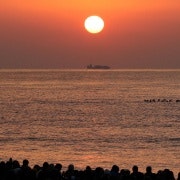Cry for kelp: The Atlantic's vital habitat warning
Rising temperatures, increasingly acidic seas and human destruction will drastically change the nature of the coastal seas of the north-east Atlantic over the next century, scientists predict.
According to new research in the journal Ecology and Evolution, it will completely alter the forests of kelp and the maerl beds of coralline algae that serve as shelter and nurseries for baby cod and juvenile scallops. These are some of the most productive habitats on Earth – habitats that also soak up carbon from the atmosphere and deliver the primary production for thriving communities of sea creatures.

Juliet Brodie, research chair of the Department of Botany at the Natural History Museum, London, reports with colleagues that their study considered changes in water chemistry, the steady rise in water temperatures, and the pattern of destruction in the northern seas – by fishermen, dredgers and pollutants. They then calculated the likely outcomes.
Invasive species
“We predict that, by 2100, warming will kill off the kelp forest in the south, ocean acidification will remove maerl beds in the north, and invasive species will thrive,” the report warns.
The sea grasses will survive only if they are protected from dredging and other human impacts. As habitats disappear, native species will perish with them, and invasive species will thrive.
Jason Hall-Spencer, a study team member and professor of marine biology at Plymouth University, UK, said: “What we find most staggering is how fast warming and the spread of corrosive waters will alter marine life around out coasts. Our shores will look very different in coming years, affecting people who make a living from the seas.”
The scientists built up a picture of the future from a study of existing research, and they concentrated on the primary producers: the plants that build up tissues from atmospheric carbon, and provide the provender and protection for a host of other species.
Significant role
Kelp forests are among the most productive habitats in the seas. Studies have found that these great, fleshy algae can consume more than a kilogram of carbon per square metre per year, so they play a significant role in the carbon cycle, and help to modify climate change.
Kelps and other seaweed species are adapted to cool waters and, as the seas warm, are predicted to become increasingly stressed. As these weaken, they will steadily be replaced by invaders from other climates. Researchers have already identified 44 species of non-native algae in the north-east Atlantic.
“Carbon dioxide emissions are causing rates of global warming and ocean acidification that will profoundly affect marine flora worldwide,” the scientists conclude.
And they warn that, unless action is taken, societies will “sleepwalk through radical ecological changes” to the plantlife of the European coasts.
Tim Radford is a reporter for Climate News Network. Climate News Network is a news service led by four veteran British environmental reporters and broadcasters. It delivers news and commentary about climate change for free to media outlets worldwide.
















